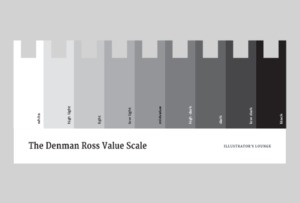
What is Value in Art?
Defined as one of the seven elements of art, next to line, shape, space, form, texture, and color, the value in art is a quality or a value of light and dark of a certain shade or tone[1]. This art element is best understood if visualized as a scale or a gradient. In 1907 Denman Ross, American painter, art collector, a scholar of art history and theory, introduced a value scale which is still used today. On such a scale, from the lightest shade, i.e. white to the darkest shade, i.e. black, various shades of gray reside. These shades of gray describe the amount of the dark or light elements of any color and describe its lightest and darkest tones or hues. Such a scale is extremely helpful for painters to identify light, mid-tones, and darks more easily.
